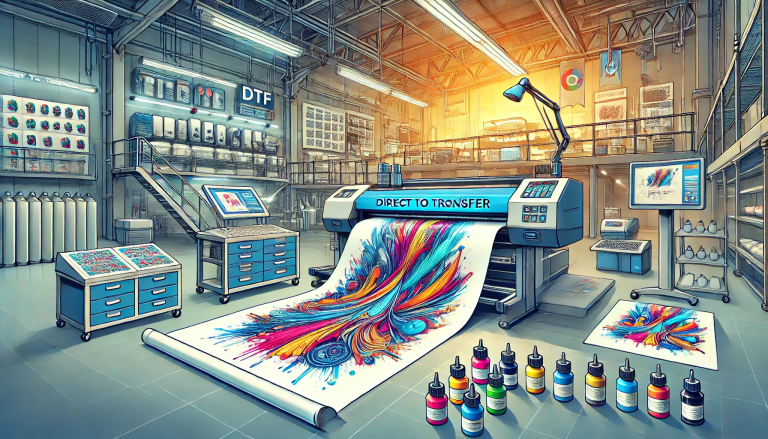“DTG vs. Heat Transfer Film: Discover the Difference!” -MAXDTF- A3 DTF paper Manufacturer, DTF Transfer Sheets Supplier, Made in china
Understanding Direct-to-Garment (DTG) Printing
What is DTG Printing?
Direct-to-Garment, or DTG, printing is a digital printing technology that involves applying designs directly onto textiles using specialized inkjet printers. The process is similar to printing on paper, but the printer is designed to handle fabrics instead. DTG printers use water-based ink that penetrates the fibers of the fabric, producing vibrant, long-lasting prints.
How Does DTG Printing Work?
- Preparation: The garment (such as a T-shirt) is placed onto a flat surface called a platen, which is designed to hold the fabric in place.
- Printing: A DTG printer sprays ink directly onto the fabric, layer by layer, using tiny nozzles. The inks are absorbed into the fibers, creating a full-color image.
- Curing: To ensure the ink adheres properly and doesn’t crack or fade, the printed garment is often heat-treated or cured using a dryer.
Advantages of DTG Printing
- High-Quality Prints: DTG produces detailed, vibrant, and full-color prints with smooth gradients and sharp images.
- Versatility: It can be used on a wide range of fabrics, including cotton, polyester, and blends.
- Short Print Runs: DTG is ideal for small to medium-sized orders, making it cost-effective for businesses with limited production needs.
- Customization: Designs can be easily changed or updated, allowing for personalized printing.
Disadvantages of DTG Printing
- Limited Fabric Types: While DTG works well on cotton, it may not produce the best results on synthetic fabrics like polyester or nylon.
- Preparation Time: Garments need to be pretreated with a solution to improve ink adhesion, which adds time to the process.
- Ink Costs: High-quality DTG inks can be expensive, driving up the cost per print.
- Production Speed: Compared to other methods like screen printing, DTG can be slower for large orders.
Understanding Thermal Transfer Film Printing
What is Thermal Transfer Film?
Thermal transfer film printing is a method that uses heat to transfer a design or pattern from a special film onto a substrate, such as fabric. The film is coated with a heat-activated ink or adhesive, which bonds to the fabric when exposed to high temperatures. This method is commonly used for creating custom labels, logos, and designs on textiles.
How Does Thermal Transfer Film Printing Work?
- Design Creation: The desired design is prepared using design software and then printed onto thermal transfer film using a specialized printer.
- Application: The film is placed onto the fabric, and a heat press applies high pressure and temperatures to activate the transfer.
- Cooling: Once the design is transferred, the fabric is allowed to cool, and the film backing is peeled away, leaving the design on the fabric.
Advantages of Thermal Transfer Film
- Durability: Thermal transfer prints are highly durable and resistant to wear, making them suitable for outdoor use or items that require frequent washing.
- Wide Fabric Compatibility: It works well on a variety of fabric types, including cotton, polyester, nylon, and blends.
- High Precision: The process allows for detailed and precise printing, making it ideal for small designs or intricate logos.
- Large Orders: Thermal transfer is suitable for large-scale production, making it a cost-effective option for businesses with high-volume needs.
Disadvantages of Thermal Transfer Film
- Limited Colors: Unlike DTG, thermal transfer film is typically limited to a few colors per design, making it less ideal for full-color images.
- Initial Investment: The cost of thermal transfer film and equipment can be high, especially for businesses that require a variety of color options.
- Manual Process: The process requires manual application, which can be time-consuming and labor-intensive.
Key Differences Between DTG and Thermal Transfer Film
1. Printing Technology
- DTG Printing: Involves direct ink application to the fabric using an inkjet printer.
- Thermal Transfer Film: Uses heat to transfer a pre-printed design from film to the fabric.
2. Quality and Color Accuracy
- DTG Printing: Produces high-quality, full-color prints with vibrant colors and smooth gradients.
- Thermal Transfer Film: Offers durability but may be limited in color options, with fewer gradients and vibrancy.
3. Fabric Compatibility
- DTG Printing: Best suited for cotton-based fabrics but can struggle with synthetic materials.
- Thermal Transfer Film: Works well on a wide range of fabrics, including cotton, polyester, and blends.
4. Cost
- DTG Printing: More expensive for large-scale production due to ink costs and slower print speeds.
- Thermal Transfer Film: More cost-effective for high-volume orders but requires a higher initial investment in equipment.
5. Applications
- DTG Printing: Ideal for small to medium-sized orders, personalized designs, and full-color artwork.
- Thermal Transfer Film: Best for large-scale production, durable prints, and applications requiring long-lasting designs.
6. Customization
- DTG Printing: Highly customizable, allowing for quick changes and updates to designs.
- Thermal Transfer Film: Limited in color options but allows for precise, intricate designs.
Choosing Between DTG and Thermal Transfer Film
The choice between DTG and thermal transfer film depends on your specific needs and requirements. Here are some factors to consider:
When to Choose DTG Printing:
- You need full-color, detailed designs with vibrant colors.
- Your order size is small to medium-sized.
- You are working with cotton-based fabrics.
- You require high levels of customization and flexibility.
When to Choose Thermal Transfer Film:
- You need durable, long-lasting prints suitable for frequent washing or outdoor use.
- Your order size is large-scale.
- You are working with a variety of fabric types, including synthetic materials.
- You require precise, detailed designs but can compromise on color options.
Conclusion
Both DTG and thermal transfer film are powerful printing methods with unique advantages and limitations. DTG excels in producing full-color, high-quality prints on cotton fabrics, making it ideal for personalized and small-scale production. On the other hand, thermal transfer film offers durability and versatility across a wide range of fabrics, making it suitable for large-scale orders and long-lasting applications.
Ultimately, the best choice depends on your specific needs, such as the type of fabric, the complexity of the design, the order size, and the desired level of customization. By understanding the differences between DTG and thermal transfer film, you can make an informed decision that ensures the best results for your project. Whether you’re a business owner, designer, or hobbyist, choosing the right printing method can make all the difference in the quality and success of your final product.




